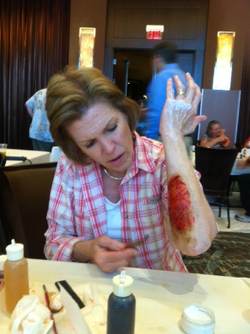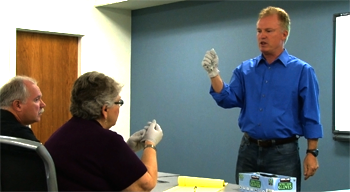Author:
|
Back to Blog
Bloodborne Pathogens (BBP) Training3/2/2015  Teaching bloodborne pathogens (BBP) is a crucial part of any emergency care class. BBP is serious stuff, and people really should be a little apprehensive when it comes to potential contact with bloodborne diseases. Once you understand how easy exposure is, or how infected, dried blood remains infectious even after 7 or more days, you are a lot more motivated to protect yourself when assisting others. That knowledge even makes you a better healthcare consumer, because now you’re watching your providers and making sure they are keeping you safe by following best practices. BBP knowledge is a win-win, and it’s so easy to incorporate into your classes. You start with your customers. Ask them about their BBP training requirements, about their company's Written Exposure Control Plan. Chances are, they’ll say they don’t have one or didn’t know they needed one. But they do need it. BBP training falls under OSHA’s general duty clause, if not specifically referenced (as in the Construction Standard), and that makes it required to be communicated to designated responders and exposed employees. Written Exposure Control Plan templates with “fill-in-the-blanks” can be purchased and the www.osha.gov website has more information on the subject. Now that you have customer buy-in and an exposure plan to work with, what you can do in the classroom itself to get your message about BBP across to your students? Mix it in. ASHI makes it easy to weave BBP into any emergency care training class. If you’re teaching Basic First Aid, just stop the video at the segment on personal safety, and if not conducting a full certification class, spend a little extra time going over BBP in greater detail. Make it part of what you do in every class, since it touches on so many other topics. You can also weave all the components of the 29CFR 1910.1030 requirements throughout the entire CPR/AED/First Aid training, as long as all required topics are covered, company-specific information is supplied, and proper donning/doffing of PPE is practiced. (You've gotta love ASHI for this flexibility!) Make it real. Often customers will let you move your group onto the actual factory floor or shop for a portion of your class time. Being in the actual workplace scene makes it real and immediate for your students. I bring an orange safety cone with a sign explaining that we’re doing a rescue scenario and that this is NOT real blood. I learned that one the hard way, when a nearby worker who was just observing saw the scenario in progress, fainted, and hit his head, giving the company its first recordable accident in over a year. Get permission to be on the floor and announce what you are doing! Be sure you weigh the value of "creative training vs potential problems" when designing your course. Make it fun. As an ice-breaker, I divide my class into three groups. Each group must come up with as many "blood-related" words (bleeding, bloody, etc.) as they can in a couple of minutes. We compare lists, crossing off every word that’s suggested by more than one group. The last group with the most unique words wins some candies or whatever I’ve brought with me. It gets them focused on the topic, gets them engaged in adult learning, and helps everyone lighten up before class starts. Do you have any BBP tips and tricks you would like to share? Please leave a comment below! OSHA requires that BBP class have to be taken once a year if you haven't had your BBP class in a few years you could be open for fines. Your CPR class every 2 years doses not meet this training need. www.cprnorthwest.com or 503-538-2610
0 Comments
Read More
Your comment will be posted after it is approved.
Leave a Reply. |

 RSS Feed
RSS Feed
